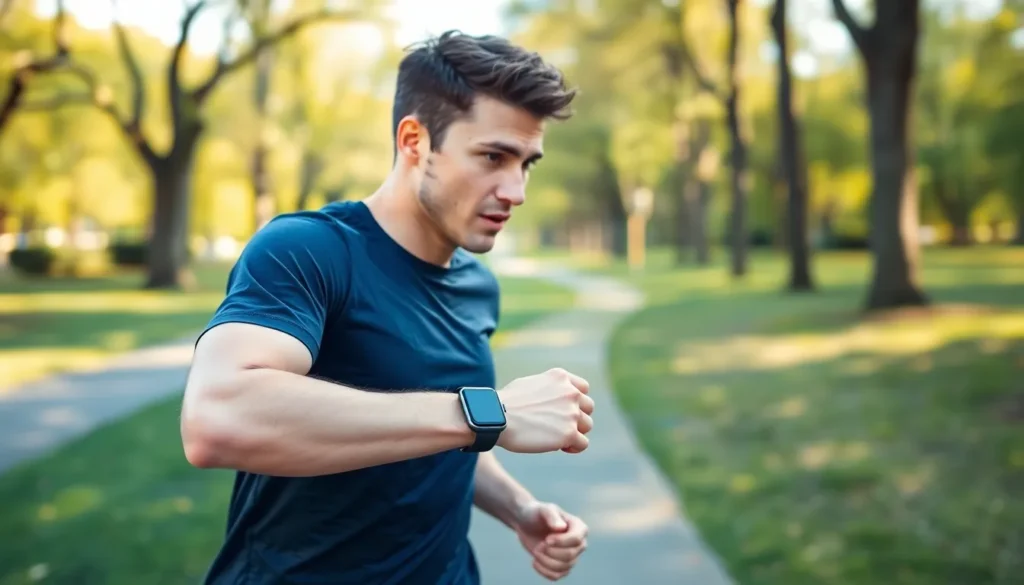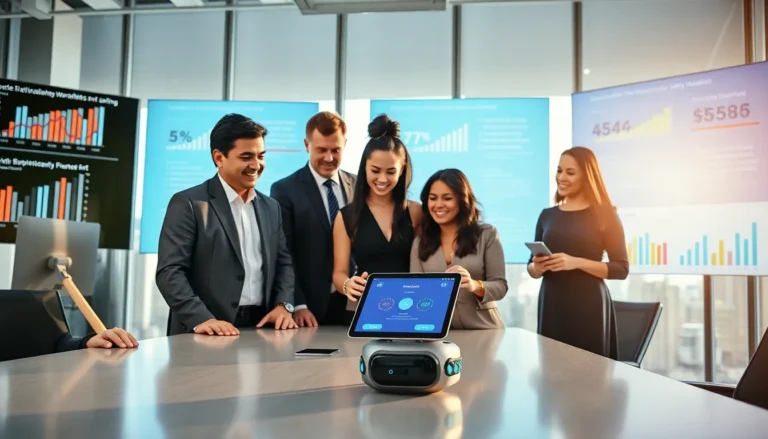Table of Contents
ToggleIn a world where technology seems to evolve faster than a caffeinated squirrel, wearable innovations are leading the charge. From smartwatches that can track your every heartbeat to fitness trackers that practically nag you to move, these gadgets are not just trendy accessories; they’re transforming how people interact with their health and daily lives.
Imagine strapping on a device that not only tells you the time but also reminds you to breathe, hydrate, and maybe even take a dance break. With the latest advancements, wearables are becoming the ultimate personal assistants, helping users stay connected and motivated. As these innovations continue to push boundaries, the question isn’t whether you should wear one; it’s which one will make you feel like a superhero on a mission to conquer the day.
Overview of Wearable Innovations
Wearable innovations are changing how people interact with technology in daily life. Smartwatches and fitness trackers dominate the market, offering real-time health data and connectivity. Health monitoring features, such as heart rate tracking and sleep analysis, help users stay informed about their physical condition. According to a 2023 report, the global wearable technology market is projected to reach $60 billion by 2024.
Fitness trackers cater to various exercises and activities. They provide insights into steps taken, calories burned, and workouts completed. Smartwatches extend functionality beyond fitness by integrating communication apps and music control. With built-in GPS navigation, users can track their outdoor activities across various terrains.
Innovative features continue to emerge in the wearables sector. Manufacturers are developing devices with advanced sensors, capable of tracking vital signs and even detecting irregular heart rhythms. Some models now focus on hydration levels and stress management through guided breathing exercises.
Wearable health technology offers significant advantages for chronic condition management. Continuous glucose monitors assist diabetics by providing vital blood sugar level data. Furthermore, heart monitors help individuals manage arrhythmias more effectively, potentially preventing serious health issues.
Engagement with wearable devices varies among consumers. Some prioritize fitness-oriented features, while others value health monitoring capabilities. The diversity in device options allows users to select devices aligning with their personal goals and preferences.
Adoption rates of wearables are rising among various demographics. Younger adults emphasize fitness tracking, while older adults gravitate toward health monitoring features. As technology advances, continual innovation in this sector promises even more transformative devices, fostering a healthier lifestyle for users.
Types of Wearable Innovations

Wearable innovations encompass a variety of devices enhancing personal health and connectivity. These devices include smartwatches, fitness trackers, and smart clothing, each serving unique functions.
Smartwatches
Smartwatches feature multifunctional capabilities beyond timekeeping. Users can track fitness metrics and receive notifications directly on their wrists. Popular models include Apple’s Watch Series and Samsung’s Galaxy Watch, equipped with health monitoring tools like heart rate sensors and ECG. Data reflects a growing trend, with the smartwatch market expected to contribute significantly to the global wearable market, projected to reach $60 billion by 2024. Enhanced connectivity options allow users to make calls and send texts, streamlining their daily lives.
Fitness Trackers
Fitness trackers are designed to monitor physical activity and overall wellness. These devices track steps taken, calories burned, and sleep patterns, providing users with valuable insights into their daily routines. Leading brands such as Fitbit and Garmin offer models tailored for various fitness levels, from casual walkers to professional athletes. Increased health consciousness drives many individuals to adopt fitness trackers, encouraging healthier habits and goal-setting. By analyzing real-time data, users can make informed decisions about their lifestyle.
Smart Clothing
Smart clothing integrates technology directly into apparel, offering innovative solutions for health monitoring. Examples include shirts and leggings fitted with sensors that track biometric data like heart rate and body temperature. Companies like Hexoskin and Athos lead the way in this evolving market. Smart clothing not only enhances athletic performance but also provides crucial information for managing chronic conditions. Wearers can benefit from comfort and style, making health tracking more accessible and appealing in everyday life.
Impact on Health and Wellness
Wearable innovations significantly influence individual health and wellness through various functionalities and features.
Monitoring Health Metrics
Wearable devices provide constant access to vital health metrics. Heart rate, sleep patterns, and activity levels are easily tracked in real-time. Advanced sensors enable monitoring of critical conditions like diabetes and heart arrhythmias. Consumers rely on data from continuous glucose monitors and heart monitors to manage their health proactively. These applications empower users with informed decision-making regarding their well-being. Reports indicate that 87% of wearers actively check health metrics daily, demonstrating the efficacy of wearables in health management.
Encouraging Physical Activity
Wearable technology encourages increased physical activity among users. Smartwatches and fitness trackers prompt reminders for movement throughout the day. Users often set personal fitness goals, with 70% indicating greater motivation from wearable devices. Notifications keep individuals engaged in daily activities, helping them establish healthier habits. The gamification of fitness challenges promotes friendly competition, boosting exercise adherence. Communities built around wearables further enhance motivation, making physical activity a more enjoyable experience.
Future Trends in Wearable Innovations
Wearable innovations are poised to redefine personal health management and connectivity. The integration of advanced technologies, particularly artificial intelligence and machine learning, sets the foundation for more personalized user experiences.
Integration with AI and Machine Learning
AI and machine learning enhance analytics and customize feedback within wearable devices. Users benefit from tailored health insights, as these technologies process vast amounts of data. Smartwatches and fitness trackers can now predict potential health issues, enabling proactive engagement. For instance, AI can analyze heart rate trends over time to identify irregularities. Furthermore, machine learning algorithms adapt notifications and exercise suggestions based on individual habits and preferences. This personalization fosters a stronger user-device connection, making fitness goals and health management more approachable.
Advancements in Battery Life and Energy Management
Longer battery life significantly increases wearable convenience. Innovations in energy management technology, including low-power sensors, allow devices to operate longer without frequent recharging. Users can now enjoy multi-day wear on fitness trackers and smartwatches. For example, some devices can last up to 14 days on a single charge. This reliability encourages continuous health monitoring, reducing the need for users to interrupt their routines. In addition, solar charging options are emerging, enabling wearables to harness sunlight for extra power. Continuous improvement in battery technology ensures that users always stay connected to their health metrics without disruption.
Challenges Facing Wearable Innovations
Wearable innovations encounter various challenges that impact their growth and adoption in everyday life.
Privacy and Data Security Concerns
Concerns about privacy and data security dominate discussions regarding wearable technology. Users frequently share personal health information, raising questions about data management and protection. Companies face scrutiny over how they collect, store, and use this data. Lack of clear regulations can lead to vulnerabilities, putting sensitive user information at risk. According to studies, 60% of consumers express hesitation about using wearables due to these privacy issues. Addressing these concerns is essential for fostering trust and encouraging wider adoption among consumers.
Adoption and Accessibility Issues
Barriers to adoption remain a significant hurdle for wearable technology. High costs often deter potential users from purchasing devices, especially among lower-income individuals. Additionally, technical literacy impacts the usability of wearables, as not everyone possesses the skills to navigate complex apps and features. Research indicates that less than 30% of older adults regularly use wearable devices, highlighting the challenge of accessibility for this demographic. Making wearables more affordable and user-friendly can facilitate broader engagement and usage across diverse age groups and backgrounds.
Wearable innovations are reshaping how individuals approach health and wellness. As technology advances these devices become more integral to daily life. With features that track vital metrics and promote active lifestyles wearables empower users to take charge of their health.
The future holds even more promise with AI integration and improved battery life. However addressing privacy concerns and making these devices accessible to all remains crucial. As the market continues to grow the potential for wearables to enhance personal health management is undeniable. Embracing these innovations can lead to healthier habits and a more connected lifestyle.




